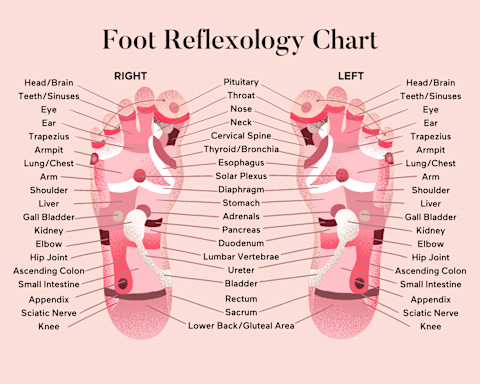Foot Reflexology 101 & A 15-Minute Practice For Better Sleep
Reflexology is the therapeutic practice of applying pressure to various points on the feet, hands, face, and ears. Foot reflexology is especially popular since there are nearly 15,000 nerves in your feet alone, making them very sensitive to touch (hence why foot massages feel so good!).
Since it's such a relaxing practice, reflexology can make a great addition to any bedtime ritual. Get started with this 15-minute reflexology routine that corresponds to body parts that are important for sleep.
What is foot reflexology?
Foot reflexology is similar to a foot massage, but it's more targeted. To do reflexology, you use your thumb and fingers or a small massage ball to apply pressure to reflex points along the foot. In a foot reflexology map (pictured below), every part of the foot corresponds to organs and glands in the body.
In many ways, this chart is thousands of years in the making: There is evidence suggesting that people practiced early forms of reflexology as far back as 2330 B.C.1 Today, the practice is most popular in Eastern medical fields such as Traditional Chinese Medicine and Ayurveda and it is easy enough to do regularly at home.

A foot reflexology routine that promotes deep sleep.
Ready to massage your way to a better snooze? The following bedtime reflexology routine can be done solo or as a nurturing ritual with a partner. You can even use these same techniques to help your child go to sleep more easily. Sweet dreams!
1. To begin, sit in a comfortable position in a quiet room. Using a light, absorbent greaseless lotion, massage the feet with squeezing, stroking, kneading, and wringing motions.
2. Next, cross your foot over your knee and hold the ankle firmly. Place the thumb of your other hand on the sole of that foot.
3. On the bottom of the foot, "walk" your thumb up from the base of the heel to each toe (imagine your thumb is a caterpillar inching its way up your foot), then press these reflex points with the outer edge of your thumb or tip of your forefinger:
- Head/brain (top of each toe) promotes clarity and positive thinking
- Pituitary or "master gland" (center of big toe) stimulates/balances hormone secretions of all other glands
- Pineal gland (outer side of big toe) secretes melatonin, which controls our circadian rhythm/sleep cycle
- Thyroid (base of big toe) balances metabolism
- Neck/shoulders (ridge of toes) releases tension
- Chest/lungs (ball of foot) calms breathing
- Solar plexus/diaphragm (under ball of foot in the center) encourages profound relaxation and peacefulness
If you have other particular areas of your body that are stressed, you can press the corresponding reflex area or point using the chart above.
4. Finish with another thumb press on the foot's solar plexus point.
5. End with "breeze strokes." Lightly run your fingertips down the tops, bottoms, and sides of each foot in a feathery motion, barely touching the skin. Repeat this several times. It is very soothing to the nerves.
6. Repeat the routine on your other foot.
Since reflexology transports you into a state of deep relaxation where you are open to suggestions, this is a good time for a pre-sleep affirmation such as: "A kind and forgiving world sings me to a peaceful sleep." Count your blessings and appreciate all of the good times in your day. Envision how you would like your next day to be before drifting asleep.
Benefits of foot reflexology.
Certain parts of the feet—also known as reflex points—are thought to correspond to other areas of the body. By stimulating them with reflexology, we are also sending a signal to those inner organs and glands.
While the scientific mechanisms involved in this process are not entirely clear, they might have to do with the peripheral nervous system, which connects our central nervous system (the brain and spinal cord) with the rest of the body and acts as a biological highway of sorts, sending signals between our limbs and brain.
While more research needs to be done on reflexology2, preliminary studies show that it can help decrease systolic blood pressure3 and promote healthy circulation4.
The safe, relaxing practice can be a complementary tool to other stress management strategies.
The takeaway.
Foot reflexology is a targeted way to ease tension in your body by way of your feet. Fifteen minutes before bed is all you need to give yourself the gift of a nourishing foot reflexology session that prepares your whole body for sleep.
